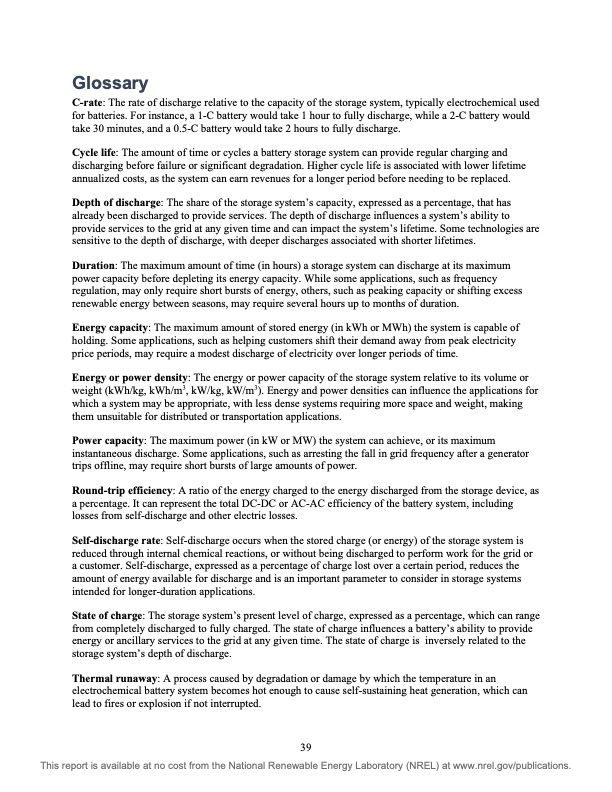
PDF Publication Title:
Text from PDF Page: 046
Glossary C-rate: The rate of discharge relative to the capacity of the storage system, typically electrochemical used for batteries. For instance, a 1-C battery would take 1 hour to fully discharge, while a 2-C battery would take 30 minutes, and a 0.5-C battery would take 2 hours to fully discharge. Cycle life: The amount of time or cycles a battery storage system can provide regular charging and discharging before failure or significant degradation. Higher cycle life is associated with lower lifetime annualized costs, as the system can earn revenues for a longer period before needing to be replaced. Depth of discharge: The share of the storage system’s capacity, expressed as a percentage, that has already been discharged to provide services. The depth of discharge influences a system’s ability to provide services to the grid at any given time and can impact the system’s lifetime. Some technologies are sensitive to the depth of discharge, with deeper discharges associated with shorter lifetimes. Duration: The maximum amount of time (in hours) a storage system can discharge at its maximum power capacity before depleting its energy capacity. While some applications, such as frequency regulation, may only require short bursts of energy, others, such as peaking capacity or shifting excess renewable energy between seasons, may require several hours up to months of duration. Energy capacity: The maximum amount of stored energy (in kWh or MWh) the system is capable of holding. Some applications, such as helping customers shift their demand away from peak electricity price periods, may require a modest discharge of electricity over longer periods of time. Energy or power density: The energy or power capacity of the storage system relative to its volume or weight (kWh/kg, kWh/m3, kW/kg, kW/m3). Energy and power densities can influence the applications for which a system may be appropriate, with less dense systems requiring more space and weight, making them unsuitable for distributed or transportation applications. Power capacity: The maximum power (in kW or MW) the system can achieve, or its maximum instantaneous discharge. Some applications, such as arresting the fall in grid frequency after a generator trips offline, may require short bursts of large amounts of power. Round-trip efficiency: A ratio of the energy charged to the energy discharged from the storage device, as a percentage. It can represent the total DC-DC or AC-AC efficiency of the battery system, including losses from self-discharge and other electric losses. Self-discharge rate: Self-discharge occurs when the stored charge (or energy) of the storage system is reduced through internal chemical reactions, or without being discharged to perform work for the grid or a customer. Self-discharge, expressed as a percentage of charge lost over a certain period, reduces the amount of energy available for discharge and is an important parameter to consider in storage systems intended for longer-duration applications. State of charge: The storage system’s present level of charge, expressed as a percentage, which can range from completely discharged to fully charged. The state of charge influences a battery’s ability to provide energy or ancillary services to the grid at any given time. The state of charge is inversely related to the storage system’s depth of discharge. Thermal runaway: A process caused by degradation or damage by which the temperature in an electrochemical battery system becomes hot enough to cause self-sustaining heat generation, which can lead to fires or explosion if not interrupted. 39 This report is available at no cost from the National Renewable Energy Laboratory (NREL) at www.nrel.gov/publications.PDF Image | USAID GRID-SCALE ENERGY STORAGE TECHNOLOGIES PRIMER

PDF Search Title:
USAID GRID-SCALE ENERGY STORAGE TECHNOLOGIES PRIMEROriginal File Name Searched:
76097.pdfDIY PDF Search: Google It | Yahoo | Bing
Turbine and System Plans CAD CAM: Special for this month, any plans are $10,000 for complete Cad/Cam blueprints. License is for one build. Try before you buy a production license. More Info
Waste Heat Power Technology: Organic Rankine Cycle uses waste heat to make electricity, shaft horsepower and cooling. More Info
All Turbine and System Products: Infinity Turbine ORD systems, turbine generator sets, build plans and more to use your waste heat from 30C to 100C. More Info
CO2 Phase Change Demonstrator: CO2 goes supercritical at 30 C. This is a experimental platform which you can use to demonstrate phase change with low heat. Includes integration area for small CO2 turbine, static generator, and more. This can also be used for a GTL Gas to Liquids experimental platform. More Info
Introducing the Infinity Turbine Products Infinity Turbine develops and builds systems for making power from waste heat. It also is working on innovative strategies for storing, making, and deploying energy. More Info
Need Strategy? Use our Consulting and analyst services Infinity Turbine LLC is pleased to announce its consulting and analyst services. We have worked in the renewable energy industry as a researcher, developing sales and markets, along with may inventions and innovations. More Info
Made in USA with Global Energy Millennial Web Engine These pages were made with the Global Energy Web PDF Engine using Filemaker (Claris) software.
Sand Battery Sand and Paraffin for TES Thermo Energy Storage More Info
| CONTACT TEL: 608-238-6001 Email: greg@infinityturbine.com | RSS | AMP |